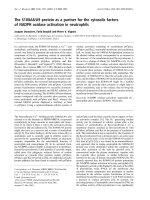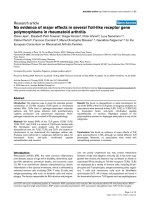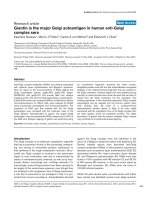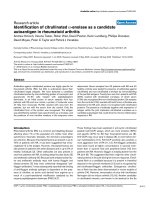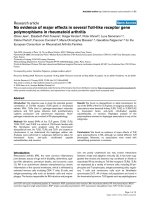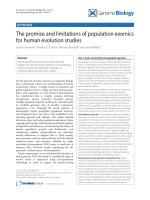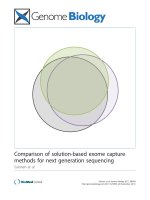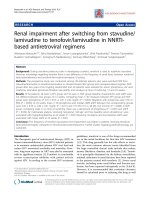Báo cáo y học: " "Metabolic staging" after major trauma - a guide for clinical decision making?" doc
Bạn đang xem bản rút gọn của tài liệu. Xem và tải ngay bản đầy đủ của tài liệu tại đây (454.75 KB, 3 trang )
Stahel et al. Scandinavian Journal of Trauma, Resuscitation and Emergency Medicine 2010, 18:34
/>Open Access
COMMENTARY
© 2010 Stahel et al; licensee BioMed Central Ltd. This is an Open Access article distributed under the terms of the Creative Commons
Attribution License ( which permits unrestricted use, distribution, and reproduction in
any medium, provided the original work is properly cited.
Commentary
"Metabolic staging" after major trauma - a guide
for clinical decision making?
Philip F Stahel*
1
, Michael A Flierl
1
and Ernest E Moore
2
Abstract
Metabolic changes after major trauma have a complex underlying pathophysiology. The early posttraumatic stress
response is associated with a state of hyperinflammation, with increased oxygen consumption and energy
expenditure. This hypercatabolic state must be recognized early and mandates an early nutritional management
strategy. A proactive concept of early enteral "immunonutrition" in severely injured patients, is aimed at
counterbalancing the negative aspects of hyperinflammation and hypercatabolism in order to reduce the risk of late
complications, including infections and posttraumatic organ failure. Recently, the concept of "metabolic staging" has
been advocated, which takes into account the distinct inflammatory phases and metabolic phenotypes after major
trauma, including the "ischemia/reperfusion phenotype", the "leukocytic phenotype", and the "angiogenic phenotype".
The potential clinical impact of metabolic staging, and of an appropriately adapted "metabolic control" and nutritional
support, remains to be determined.
Commentary
In a recent article published in the Journal, Aller and col-
leagues propose a modern perspective on the metabolic
events associated with the inflammatory response to
major trauma, which should guide therapeutic strategies
[1]. The authors classified the metabolic changes after
injury into three distinct phenotypes: (1) the "ischemia/
reperfusion phenotype"; (2) the "leukocytic phenotype";
and (3) the "angiogenic phenotype". Using this innovative
classification concept, the authors explain the metabolic
alterations in association with the "classical" progression
of posttraumatic inflammation. The first ("ischemia/rep-
erfusion") phenotype represents the immediate, nervous
system-related alteration in response to injury, in which
neuronal and humoral responses and edema formation
predominate. This phase is characterized by regulating
the metabolic supply to cells via the least elaborate mech-
anism: diffusion. The second ("leukocytic") phenotype, is
characterized as the intermediate (or "immune") phase of
the metabolic response to trauma. This phase is charac-
terized by leukocytic and bacterial infiltration of previ-
ously damaged tissues, which occurs in an edematous,
oxygen-poor environment. The resulting post-shock
hypercatabolism and hypermetabolism is related to a
hyperdynamic response with increased body tempera-
ture, increased oxygen consumption, glycogenolysis,
lipolysis, proteolysis and futile substrate cycling. The
third ("angiogenic") phenotype is defined as the late (or
"endocrine") phase of systemic response to injury. This
phase is characterized by a return of oxidative metabo-
lism, favoring angiogenesis in damaged tissues and
organs. This process creates a capillary bed that facilitates
tissue repair and regeneration.
In 1942, Cuthbertson was the first to describe distinct
phases of the metabolic changes which occur after major
trauma [2,3]. He characterized the "ebb" and the "flow"
phases of posttraumatic metabolic alterations. The "ebb"
phase is associated with a decline in body temperature
and oxygen consumption, presumably aimed at reducing
posttraumatic energy depletion. The brief duration of this
phase limits its clinical relevance. In contrast, the "flow"
phase occurs after resuscitation from a state of shock,
which leads to an increased metabolic turnover, activa-
tion of the innate immune system and induction of the
hepatic acute-phase response. This hypercatabolic condi-
tion leads to a significantly increased oxygen consump-
tion and energy expenditure. The state of
hypercatabolism has been associated with severe compli-
cations after major trauma, related to hyperglycemia,
* Correspondence:
1
Department of Orthopaedic Surgery Denver Health Medical Center
University of Colorado School of Medicine 777 Bannock Street Denver, CO
80204 USA
Full list of author information is available at the end of the article
Stahel et al. Scandinavian Journal of Trauma, Resuscitation and Emergency Medicine 2010, 18:34
/>Page 2 of 3
hypoproteinemia, and immunosuppression. The pres-
ence and significance of these metabolic alterations must
be recognized and managed early in multiply injured
patients [4,5]. The catabolic state requires an adjusted
energetic balance with early protein substitution and
hypercaloric nutrition. Early enteral nutrition has been
advocated as the concept of choice for nutrition of poly-
traumatized and severely ill patients. In this regard, pro-
spective randomized controlled trials in the 1980s have
clearly demonstrated the positive effect of an early full
enteral nutrition with a decreased posttraumatic infec-
tion rate, a shorter duration of hospital stay, and an
improved overall outcome [6,7]. The concept of "immu-
nonutrition" is exemplified by the enteral supplementa-
tion of glutamine, an essential amino acid which exerts
metabolic benefits beyond its nutritional value by medi-
ating immunological effects, such as induction of neutro-
phil phagocytic activity and oxidative burst [8]. In
addition, glutamine is a precursor to the reducing agent
glutathione and thus contributes to antioxidant effects
and cellular protection from ischemia/reperfusion-medi-
ated injury [9]. A prospective, randomized, double-blind
controlled clinical trial demonstrated that glutamine sup-
plementation reduces the incidence of multiple organ
failure and death attributed to infections in critically ill
patients [10]. In addition to glutamine, Ω- fatty acids have
become an important nutritional supplementation for
severely injured patients [11]. These long-chain polyun-
saturated fatty acids derived from fish oil were shown to
have potent anti-inflammatory properties, related to the
attenuation of arachidonic acid-derived metabolites like
thromboxane A
2
and leukotriene B
4
, inhibition of leuko-
cyte activation and chemotaxis, and attenuation of pro-
inflammatory gene expression levels. Other nutritional
supplements that promote anabolism in trauma patients
include phospholipids, leptins, and anabolic hormones,
such as thyroid hormones, growth hormone, and insulin.
For example, growth hormone substitution has been
shown to promote protein anabolism in severely injured
patients.
The proposed metabolic classification in the paper by
Aller and co-workers [1] is intuitively attractive, but is
currently quite limited in application. The metabolic
response to injury is complex and fundamentally driven
by the combination of the primary events of tissue isch-
emia/reperfusion and tissue disruption. The response is
further modified by innate gene expression and genetic
polymorphisms, and aggravated by secondary events
such as blood transfusions, delayed operative procedures,
and infection [12,13]. These events provoke initiation of
the cellular immune system (monocytes/macrophages,
neutrophils, and endothelium), upregulation of Toll-like
receptors (TLRs), activation of complement and coagula-
tion cascades [12]. These immunological changes ulti-
mately result in the notable release of a multitude of
mediators including cytokines, chemokines, eicosanoids,
oxidants, proteases, nitric oxide, alanine, and damage-
associated molecular patterns (DAMPs)[12]. The
released mediators are ultimately responsible for the met-
abolic response to injury as well as microvascular throm-
bosis, mitochondrial dysfunction, cellular necrosis and
apoptosis, and ultimately secondary remote organ dys-
function (Figure 1). In fact, our therapeutic strategies to
meet the metabolic needs of the injured patient have not
gone much beyond the classic description of the "ebb" and
"flow" phase proposal by Cuthbertson in 1942 [2,3]. As
outlined above, the "ebb" phase, corresponding to the pro-
posed "ischemia/reperfusion phenotype", is relatively
brief, spanning < 12 hrs in most severely injured patients,
with some extreme cases up to 24 hrs. During the resusci-
tation phase, there has been some evidence to initiate
early β-blockade and antioxidant therapy, and even intes-
tinal intraluminal glutamine administration, a concept
which remains controversial [14]. As noted above, the
brief duration of the initial phenotype phase limits its
clinical relevance. The proposed "leukocyte phase" is
where the focus on metabolic support has had the great-
est impact on patient outcome. This period would physi-
ologically correspond to Cuthbertson's "flow" phase
where there is sustained hypermetabolism for at least 7
days, and in many severely injured patients for up to 3
weeks and longer [4,5]. During this initial period there is
increased oxygen consumption, insulin resistance, and
protein catabolism. Modest hyperglycemia is common
due to increased hepatic glucose production and periph-
eral insulin resistance in skeletal muscle [15]. Changes in
lipid metabolism include increased lipolysis, fatty acid
Figure 1 Simplified schematic representing the current under-
standing of the pathophysiological reactions to major trauma,
which lead to secondary remote organ dysfunction.
(Abbreviations: TLR, Toll-like receptor; DAMPs, damage-associated mo-
lecular patterns.)
Tissue
ischemia/reperfusion
Tissue disruption
Genetic modication
Cholinergic response
Blood transfusion
TLR activation
Coagulation
activation
Complement
activation
Macrophage
activation
Endothelial
activation
Neutrophil
priming
Cytokines, chemokines,
eicosanoids, nitric oxide, oxidants, proteases,
DAMPS, alarmins
Organ dysfunction
Exaggerated
innate immunity
Microvascular
thrombosis
Endothelial &
epithelial barrier
failure
Mitochondrial
dysfunction
Cellular
dysfunction
Apoptosis
+
-
Supressed
adaptive immunity
Stahel et al. Scandinavian Journal of Trauma, Resuscitation and Emergency Medicine 2010, 18:34
/>Page 3 of 3
recycling, hypertriglyceridemia, and hepatic steatosis
[16]. The postinjury hypermetabolism is further charac-
terized by increased skeletal and visceral muscle catabo-
lism and negative nitrogen balance, leading to depletion
of lean body mass, a syndrome which has been referred to
as "autocannibalism" [17]. Glutamine released from mus-
cle becomes the preferred energy substrate for entero-
cytes and immune cells, and is used to synthesize the
antioxidant glutathione [18]. Hepatic protein synthesis is
prioritized to generate acute phase proteins, such as C-
reactive protein, at the expense of constitutive proteins,
such as albumin and other carrier proteins [19]. Thus,
appropriate nutritional therapy is integral in the manage-
ment of severely injured patients that includes early
enteral feeding, high protein administration, selective
immunomodulation with diet enriched in glutamine and
Ω- fatty acids [4,5,7]. Providing appropriate nutritional
support becomes more challenging in patients who
develop organ dysfunction as a result of their injuries and
profound shock [20].
The authors propose a third, "angiogenic phenotype"
[1]. But, again, the focus on angiogenesis may be some-
what myopic. On one hand, discerning the angiogenic
phase from the leukocyte will be difficult as the two pro-
cesses overlap. On the other hand, the nutritional needs
are largely dictated by the metabolic state described in
the leukocyte phase.
Based on these distinct pathophysiological phases of
posttraumatic metabolic alterations, the authors deduce
the need for a "metabolic staging" after severe trauma [1].
This implies the adjustment of the nutritional needs,
which should be adjusted in a staged fashion to the differ-
ent metabolic phases after major trauma. The authors
conclude that a better understanding of these pathophys-
iological events may provide the treating clinician with
novel and innovative therapeutic approaches, which
include providing the most appropriate metabolic sup-
port dependent on the predominant phase and pheno-
type of metabolic alterations. The potential clinical
impact and the feasibility of a, likely over-simplified, con-
cept of "metabolic staging" in the guidance and decision
making for the nutritional support of severely injured
patients remains elusive.
Competing interests
The authors declare that they have no competing interests.
Author Details
1
Department of Orthopaedic Surgery Denver Health Medical Center University
of Colorado School of Medicine 777 Bannock Street Denver, CO 80204 USA
and
2
Department of Surgery Denver Health Medical Center University of
Colorado School of Medicine 777 Bannock Street Denver, CO 80204 USA
References
1. Aller MA, Arias JI, Alonso-Poza A, Arias J: A review of metabolic staging in
severely injured patients. Scand J Trauma Resusc Emerg Med 2010, 18:27.
2. Cuthbertson DP: Post-shock metabolic response. Lancet 1942, 1:343-37.
3. Cuthbertson DP: The metabolic response to injury and other related
explorations in the field of protein metabolism: an autobiographical
account. Scott Med J 1982, 27:158-71.
4. Biffl WL, Moore EE, Haenel JB: Nutrition support of the trauma patient.
Nutrition 2002, 18:960-5.
5. Hasenboehler E, Williams A, Leinhase I, Morgan SJ, Smith WR, Moore EE,
Stahel PF: Metabolic changes after polytrauma: an imperative for early
nutritional support. World J Emerg Surg 2006, 1:29.
6. Moore EE, Jones TN: Benefits of immediate jejunostomy feeding after
major abdominal trauma - a prospective randomized study. J Trauma
1986, 26:874-81.
7. Moore FA, Moore EE, Kudsk KA, Brown RO, Bower RH, Koruda MJ, Baker CC,
Barbul A: Clinical benefits of an immune-enhancing diet for early
postinjury enteral feeding. J Trauma 1994, 376:607-15.
8. Heyland DK, Novak F, Drover JW, Jain M, Su X, Suchner U: Should
immunonutrition become routine in critically ill patients? A systematic
review of the evidence. JAMA 2001, 286:944-53.
9. Wernerman J: Glutamine and acute illness. Curr Opin Crit Care 2003,
9:279-85.
10. Griffiths RD, Allen KD, Andrews FJ, Jones C: Infection, multiple organ
failure, and survival in the intensive casre unit: influence of glutamine-
supplemented parenteral nutrition on acquired infection. Nutrition
2002, 18:546-52.
11. Calder PC: Long-chain omega-3 fatty acids and inflammation: potential
application in surgical and trauma patients. Braz J Med Biol Res 2003,
36:433-46.
12. Stahel PF, Smith WR, Moore EE: Role of biological modifiers regulating
the immune response after trauma. Injury 2007, 38:409-22.
13. Stahel PF, Moore EE, Schreier SL, Flierl MA, Kashuk JL: Transfusion
strategies in postinjury coagulopathy. Curr Opin Anaesthesiol 2009,
22:289-98.
14. Omata J, Fukatsu K, Ueno C, Maeshima J, Saitoh D, Mochizuki H:
Intraluminal glutamine administration during ischemia worsens
survival after gut ischemia-reperfusion. J Surg Res 2007, 143:260-4.
15. Mizock BA: Alterations in fuel metabolism in critical illness:
Hyperglycaemia. Best Pract Res Clin Endo Metab 2001, 15:533-51.
16. Mizock BA: Metabolic derangements in sepsis and shock. Crit Care Clin
2000, 16:319-36.
17. Cerra FB, Siegel JH, Coleman B, Border JR, McMenamy RR: Septic
autocannibalism: A failure of exogenous nutritional support. Ann Surg
1980, 192:570-80.
18. Bongers T, Griffiths RD, McArdle A: Exogenous glutamine: the clinical
evidence. Crit Care Med 2007, 35(9 Suppl):S545-52.
19. Shaw JHF, Wolfe RR: An integrated analysis of glucose, fat and protein
metabolism in severely traumatized patients. Studies in the basal state
and the response to total parenteral nutrition. Ann Surg 1989,
209:63-72.
20. Stahel PF, Smith WR, Moore EE: Current trends in resuscitation strategy
for the multiply injured patient. Injury 2009, 40(Suppl 4):S27-35.
doi: 10.1186/1757-7241-18-34
Cite this article as: Stahel et al., "Metabolic staging" after major trauma - a
guide for clinical decision making? Scandinavian Journal of Trauma, Resuscita-
tion and Emergency Medicine 2010, 18:34
Received: 11 June 2010 Accepted: 17 June 2010
Published: 17 June 2010
This article is available from: 2010 Stahel et al; licensee BioMed Central Ltd. This is an Open Access article distributed under the terms of the Creative Commons Attribution License ( ), which permits unrestricted use, distribution, and reproduction in any medium, provided the original work is properly cited.Scandinavi an Journal of Trau ma, Resuscitatio n and Emergency Medicine 2010, 18:34

